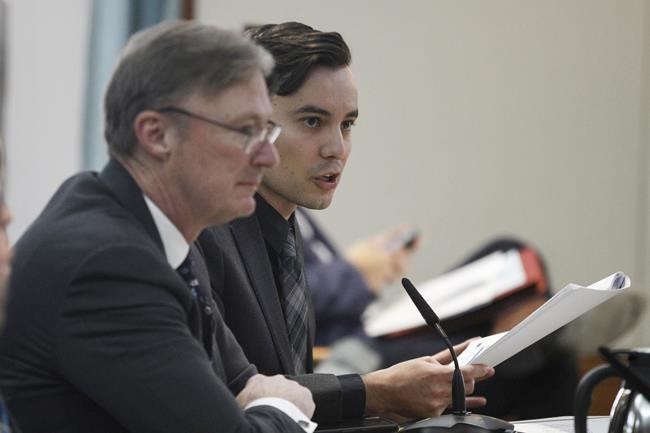SANTA FE, N.M. (AP) ŌĆö A windfall in government income from petroleum production is slowing down but far from over in New Mexico as the nation's No. 2 oil-producing state grapples with how much it can effectively spend ŌĆö and for the future in case the world's thirst for oil falters.
The state is headed for a $3.5 billion general fund surplus for the year running through June 2025, according to a new forecast Monday. New MexicoŌĆÖs annual state government income has swelled by nearly 50% over the past three years, driven largely by oil an natural gas production in the Permian Basin, the most prolific shale-oil producing region in the country that extends across southeastern New Mexico and portions of western Texas.
The state will draw in a record-setting $13 billion ŌĆö exceeding annual spending obligations by one-third, economists from four state agencies said in a presentation to a legislative panel. Monday's forecast anticipates 2.2% growth in state government income, on top of 10.2% growth during the current budget year.
The estimate of government income sets a baseline for budget negotiations when the Democratic-led Legislature convenes in January, and could extend efforts to set aside money to ensure critical programs endure . The forecast cautions that slowing oil production and lower prices are expected to generate significantly less federal payments next year and beyond.
By the end of the decade, oil income is likely to begin a long, steady decline, ŌĆ£becoming a drag on revenue growth as global demand wanes,ŌĆØ the report states.
Permian Basin production and revenue would be lower in the future if countries ŌĆ£make goodŌĆØ on their promises as part of the Paris Agreement, said Daniel Raimi, a fellow at the Washington-based nonpartisan economics group Resources for the Future, which does not advocate on energy policies. In 2015, countries at the United Nations climate conference signed onto the agreement to limit the average warming across the globe to ŌĆ£well belowŌĆØ 2 degrees Celsius (3.6 F) and pursue efforts to cap warming to 1.5 degrees (2.7 F).
ŌĆ£It really hinges a lot on the different policies that governments around the world implement,ŌĆØ Raimi said.
About half of the New MexicoŌĆÖs general fund revenue can be traced to the oil and natural gas sector through an array of taxes and royalties on petroleum production that takes place largely on public lands ŌĆö and distributions that flow from the stateŌĆÖs $28 billion land grant permanent fund for education, which is nurtured by oil income and investment earnings.
New MexicoŌĆÖs largest source of income is about renewable energy production, adoption of electric vehicles, and new applications for nuclear power that could reduce fossil fuel use.
The state is looking for new revenue streams that shift the state's dependence on oil, including New Mexico Gov. Michelle Lujan GrishamŌĆÖs proposal last week to help preserve freshwater aquifers with a $500 million initiative to . Early critics fear the plan might only spur more drilling for petroleum.
ŌĆ£We put a ton of money into funds,ŌĆØ Lujan Grisham said from the U.N. climate conference in the United Arab Emirates, where calls to phase-out the use of fossil fuels have been on prominent display. ŌĆ£But you also have to create revenue streams that go into those funds that are reliable.ŌĆØ
Meanwhile, the growth in government income has allowed the state to expand agency budgets, scale back taxes, and offer new support to families, while bolstering spending on public education and colleges that account for roughly 58% of annual state general fund spending.
ItŌĆÖs more money in many instances than school districts and state agencies can effectively spend, as lawmakers push to bring average high school graduation rates and academic attainment up to national averages.
ŌĆ£All the resources have been there to pay the teachers more, to do the afterschool programing to provide the tutoring and support,ŌĆØ said Charles Sallee, director of the LegislatureŌĆÖs budget and accountability office, at a recent community presentation. ŌĆ£ItŌĆÖs the ability of the bureaucracy to organize and use those resources. In many cases itŌĆÖs strained at capacity.ŌĆØ
Frustration boiled over at a recent legislative hearing that examined state spending on public education and stagnant average student performance at public schools.
Statewide, the share of students who can read at their grade level is 38%. Math proficiency is at 24%. The stateŌĆÖs high school graduation rate hovers at 76% ŌĆö well below the national average of 87%.
Funding is increasing while the student population is declining, said Democratic state Sen. George Mu├▒oz of Gallup, chairman of the lead state budget-writing committee at a November hearing.
ŌĆ£So weŌĆÖre paying more for kids and weŌĆÖre still not getting there,ŌĆØ Mu├▒oz said. ŌĆ£What are we going to do to move the needle?ŌĆØ
New MexicoŌĆÖs early childhood education trust, created in 2020, already holds roughly $6 billion. It's designed to safeguard an ambitious expansion of public preschool, no-cost child care and home nurse visits for infants.
Last year, legislators agreed to set aside $150 million in a new land and water conservation fund and agreed to channeled more money from oil and natural gas into a savings account for construction projects ŌĆö devoting $3 billion by 2027.
Legislators still are pushing to open new savings accounts. An emerging proposal would devote $100 million to a trust for Native American education including Indigenous language instruction among 23 tribal communities in New Mexico, including the Navajo Nation.
Morgan Lee, The Associated Press



